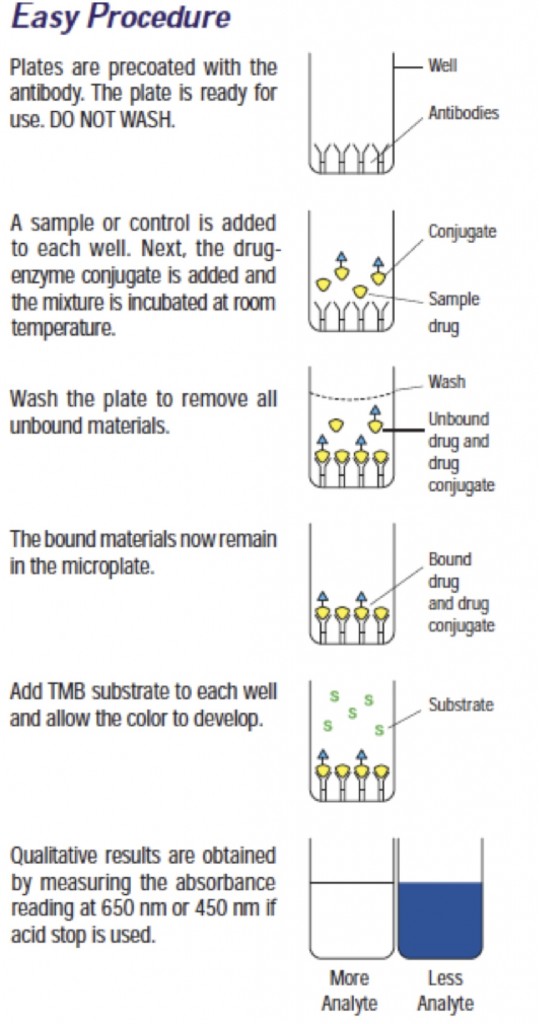Enzyme immunoassay (EIA) or Enzyme-Linked Immunosorbent Assay (ELISA) (ELIA) is often a colormetric test whereby an enzyme is added to the prepared unknown and the reaction that occurs is either positive or negative.
Assay Principle:
ELISA assays operate on the basis of competition between the drug or its metabolite in the sample and the drug-enzyme conjugate for a limited number of specific binding sites on the precoated microplate.
The simple assay procedure includes the addition of samples, calibrators or controls to the antibodycoated microplate followed by the addition of the enzyme conjugate. During incubation, the drug in the sample and the drug enzyme conjugate compete for binding sites on the antibody-coated microplate. After the incubation, the microplate is washed and a Substrate is typically added. After the substrate incubation, the test can be read visually or with a microplate reader or stop solution can be used. The extent of color development is inversely proportional to the amount of drug in the sample or control/caliborator. The absence of the drug in the sample will result in a color, whereas the presence of the drug will result in decreased or no color development.

People like to call it a screening test, but it is not properly thought of in that manner. It is actually an Exclusion Screen.
By definition, a screening test is designed to be quick. Very quick. In science, like most things in life, you can either have fast or good. You cannot have both fast and good. With screening tests the trade-off is to get a fast result, and hence you must compromise good. What this means is that you have a quick test with a fast answer with a low false negative rate, but a high rate of false positives. This is done so as to shorten the analysis sample time. If it comes back with a negative for a drug (that drug is excluded), then no further testing is necessary. No GC-MS, which takes much more time and expertise in arriving at a result. Technically, this feature of high rates of false positive, but low rates of false negatives EIA/ELISA is referred to as being non-specific, but somewhat selective.
These tests are designed to act like a spaghetti strainer for spaghetti in that it is designed so that no spaghetti gets through but all water does. However, as we know small enough diameter spaghetti sometimes gets through, but regardless not all water flushes out. What you are left with at the end of using this devices is almost all spaghetti, but very little water.
The best and most easily relatable and transferable concept that illustrates the point is as follows:
If you want to identify every one of five potential terrorists out of ten million air travelers, be prepared to do a lot of searches that turn up nothing.
Some YouTube for you:
In conclusion, no real scientist would ever be comfortable identifying that a certain analyte was present with simply a screening test for this very reason. Confirmation is required.


